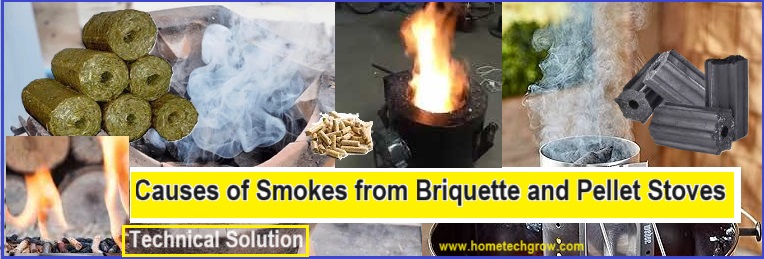Major Causes of Smokes from the Biomass Stoves
- High levels of smoke from biomass briquette stoves can be attributed to various factors related to combustion efficiency, fuel characteristics, and stove design.
- Identifying and addressing these causes is crucial for minimizing smoke emissions.
- Addressing the following factors through proper stove maintenance, biomass fuel preparation, and user education is essential for reducing smoke emissions from biomass briquette stoves.
- Regular inspections and adherence to best practices can significantly improve combustion efficiency and air quality.
- Here are some common reasons for high smoke production:
Incomplete Combustion:
- Incomplete combustion occurs when there is insufficient oxygen available for the combustion process.
- It can result from a lack of proper air intake or poor airflow within the combustion chamber.

Moisture Content in Briquettes:
- High moisture content in biomass briquettes hinders the combustion process.
- Wet or improperly dried briquettes can produce more smoke and less heat. It’s important to use well-dried briquettes with low moisture content.
Low-Quality Briquettes:
- Briquettes made from low-quality biomass materials, with inadequate binding agents or improper compression, may not burn efficiently.
- Choosing high-quality briquettes with the right composition is essential to reduce smoke emissions.
Incorrect Fuel Size:
- Using briquettes that are too large or too small for the stove’s combustion chamber can lead to inefficient burning and increased smoke production.
- Ensure the briquette size is suitable for the stove.
Poor Stove Design:
- Stoves with suboptimal designs, such as inadequate airflow pathways or poorly designed combustion chambers, can contribute to inefficient combustion and increased smoke.
- Selecting a stove with an efficient design is crucial.
Insufficient Preheating:
- Starting the stove with insufficient preheating or using cold fuel can contribute to incomplete combustion and smoke.
- Preheating the stove adequately before adding the main fuel helps establish a hot burn.
Airflow Restrictions:
- Blockages or restrictions in the air intake, exhaust system, or chimney can hinder proper airflow, leading to incomplete combustion and increased smoke.
- Regular cleaning and maintenance are necessary to prevent airflow issues.
Excessive Biomass Fuel Loading:
- Overloading the stove with too much biomass fuel can overwhelm the combustion process, resulting in incomplete burning and increased smoke production.
- Follow the manufacturer’s recommendations for proper fuel loading.
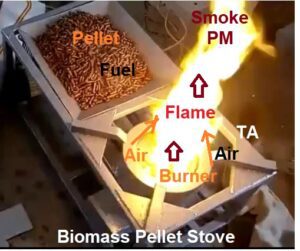
Operator Error:
- Lack of understanding or incorrect operation by users can contribute to inefficient combustion.
- Educating users on proper stove operation, including pellet fuel loading and air adjustment, is crucial to minimizing smoke emissions.
Poor Draft:
- An inadequate draft in the chimney or flue can affect the removal of combustion byproducts.
- Ensure that the chimney is properly designed and installed to promote good draft.
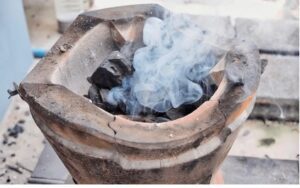
Altitude and Climate:
- Altitude and climate conditions can affect combustion efficiency.
- Adjustments may be needed in terms of air intake and fuel loading to account for variations in air density.
Improper Fuel Storage:
- Storing biomass briquettes in damp or humid conditions can increase their moisture content, leading to poor combustion and higher smoke emissions.
- Properly store briquettes in a dry environment.
Smoke and Dust Minimization Techniques
- Minimizing smoke and dust emissions from briquette and pellet stoves is essential for both environmental and health reasons.
- Many technological evolutions have been made to improve the quality of biomass fuel and stove design to reduce smoke with a lot of research.
- Some standard practices have been developed but these are not sufficient for many domestic and commercial applications
- Here are some techniques to achieve this:
Use High-Quality Biomass Fuel:
- Choose high-quality briquettes or pellets made from well-dried and compacted biomass materials.
- Low-quality fuels tend to produce more smoke and ash.
Proper Storage:
- Store biomass fuel in a dry and well-ventilated area to prevent moisture absorption, which can lead to increased smoke emissions during combustion.
Regular Maintenance:
- Keep the stove and flue clean by performing regular maintenance.
- Clean the ash pan and remove ash buildup from the burn chamber to maintain efficient combustion.
Optimal Airflow:
- Adjust the air intake controls on the stove to optimize airflow. Too much or too little air can affect combustion efficiency.
- Follow the manufacturer’s guidelines for proper air adjustment.
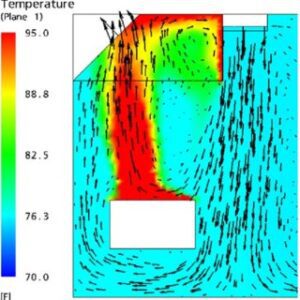
Correct Sizing:
- Ensure that the briquettes or pellets used are of the correct size for your stove.
- Using improperly sized fuel can lead to incomplete combustion and increased emissions.
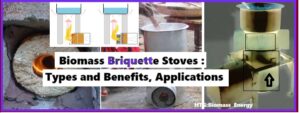
Combustion Chamber Design:
- Choose stoves with well-designed combustion chambers that promote efficient burning and reduce the likelihood of smoke production.
Advanced Combustion Technologies:
- Consider stoves equipped with advanced combustion technologies, such as secondary combustion chambers or gasification systems.
- These features can enhance combustion efficiency and minimize emissions.
Moisture Content Control:
- Control the moisture content of the biomass fuel.
- Wet fuel can result in incomplete combustion, increased smoke, and higher emissions.
- Aim for a moisture content within the recommended range.
Use of Additives:
- Some additives or binders can be incorporated into the briquettes during the manufacturing process to improve combustion efficiency and reduce emissions.
Train and educate the Users:
- Provide clear instructions to users on the proper operation and maintenance of the stove.
- Users should understand the importance of using high-quality fuel, maintaining optimal airflow, and performing regular cleaning.
Install Adequate Ventilation:
- Ensure proper ventilation in the room where the stove is installed to minimize indoor air pollution.
- This can be achieved through well-designed ventilation systems.
Conclusions
- By implementing these techniques, you can minimize smoke and dust emissions from briquette and pellet stoves, promoting cleaner and more efficient
- Choose stoves that comply with emission standards and regulations.
- Look for certification labels to ensure that the stove meets environmental and safety requirements.
